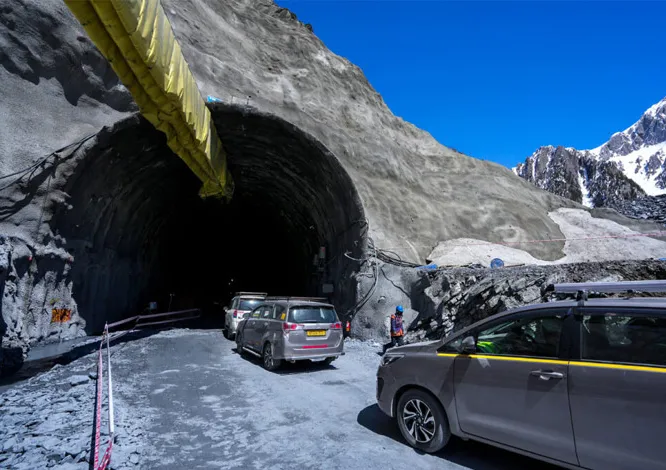
India has been proactively ramping up all-weather, multimodal connectivity infrastructure in the Kashmir Valley and Ladakh since 2019, following Chinese belligerence along the line of actual control (LAC) and in Pakistan-Occupied Kashmir (POK). Despite the treacherous terrain, complex geology, harsh weather conditions and bureaucratic hurdles, New Delhi has pursued connectivity projects ardently given the region’s geostrategic and geoeconomic importance. Most projects, including the world’s highest cable-stayed Chenab Bridge (1315 mt), the T49 rail tunnel (12.77 km) and the Zojila tunnel (13.5 km), signify India’s marvellous engineering feat and strategic heft over adversaries.
China’s hostility along LAC and in POK
In an attempt to increase its geostrategic and geopolitical influence over Xinjiang and Tibet, the Communist Party of China (CPC) started the construction of roads and other infrastructure in 1949. China’s dominance over the region grew manifold after the establishment of the Xinjiang Production and Construction Corps (XPCC) in 1954. Initially comprised of decommissioned soldiers and dominated mainly by Hans, the XPCC’s mandate was to develop agriculture, economy, and connectivity in frontier areas.
China’s dominance over the region grew manifold after the establishment of the Xinjiang Production and Construction Corps (XPCC) in 1954.
With a military structure and hybrid modes of enterprise and bureaucracy, XPCC constructed the Xinjiang-Xizang (Tibet) highway in 1958 through Indian territory in Aksai Chin. The strategic Karakoram highway, mostly constructed by Peoples Liberation Army was completed in 1979 and was opened to traffic in 1982. In 1958, Beijing also started constructing a railway line from Lanzhou to Siling to connect the Tibetan plateau to China by rail. The project was completed in 1959 and by 1961, China established full connectivity with the Tibetan plateau by rail. Two other railway lines joined Gansu to Urumqi in Xinjiang and Lanzhou to Baotou in Inner Mongolia. Lanzhou-Xinjiang line was extended to Kashgar in 1999 and further to Khotan by 2011 for strategic reasons. Currently, there are three lines linking Tibet with other parts of China-Qinghai-Tibet link (2006), Lhasa-Shigatse rail (2014), and Lhasa-Nyingchi line (2021). With political designs and in pursuance of its expansionist policies, the CPC also plans to connect Xinjiang with Tibet via a railway line running close to the LAC. The rail line, designed through the disputed Aksai Chin region, is expected to be completed in 2035.
As it gained economic heft since the turn of the century, China matched its increasing financial prowess with its military ambitions to encircle India with the controversial and sensitive China-Pakistan Economic Corridor (CPEC)—which violates Indian sovereignty in POK. China invested billions of dollars in linking the restive Xinjiang province with the Gwadar port in the Arabian Sea. It also helped Pakistan to build defence infrastructure, including bunkers, roads, tunnels and bridges along the LoC. Suspicious of Pakistani officials’ ties with terror organisations in the area, China has also deployed People’s Liberation Army soldiers and members of the XPCC to guard its CPEC projects in the POK. Furthermore, in a move that can have more serious strategic implications for India, China and Pakistan are planning the Muzaffarabad-Shaksgam-Yarkand road, which will shorten the existing road travel distance between the two nations by around 350km.
India's strategic deterrence and multimodal infrastructure
To counter the growing encirclement of its northern territory by China that threatens its sovereignty and integrity, India has embarked on mega multimodal connectivity projects in the Kashmir Valley and Ladakh. Most of these projects for strategic deterrence are expedited after 2019, and are regularly monitored directly by India’s Prime Minister.
Suspicious of Pakistani officials’ ties with terror organisations in the area, China has also deployed People’s Liberation Army soldiers and members of the XPCC to guard its CPEC projects in the POK.
Udhampur-Srinagar-Baramulla Railway link
The 272-km-long Udhampur-Srinagar-Baramulla Railway Link (USBRL), proclaimed a “national project” in 2002, is considered to be one of India’s most important strategic projects. The project was constructed in four phases with an estimated cost of INR 37,021 crores. The Baramulla-Qazigund section, spanning 118 km, was commissioned in 2009. The 19-km Qazigund-Banihal section was commissioned in 2013, followed by the 25-km Udhampur-Katra section in 2014. The 111-km Banihal-Katra section of the project that runs through treacherous terrain is now in its final stages of completion. The USBRL to be commissioned by March 2024, features 38 tunnels, including the longest T49 tunnel spanning 12.77 km.
The Indian government had undertaken an ambitious project to widen the strategic 295-km highway (NH44) into a four-lane road back in 2011. Four of the six projects are complete. The remaining 79-km four-lane stretch will have 14 tunnels, costing INR 5,118 crores. The project is expected to be completed by 2024, reducing the travel time from Srinagar to Jammu from 12 to 4 hours. The highway is home of longest tunnels like Chenani-Nashri tunnel (10.89 km), Qazigund-Banihal tunnel (8.45 km) and other smaller tunnels along the road.
Z-Morh and Zojila tunnels on Srinagar-Leh Highway
After 2019, New Delhi also expedited the construction of two tunnels on the Srinagar-Leh strategic highway to shorten the distance and provide all-weather access to Ladakh. The work on the 6.5 km Z-Morh tunnel between Gagangir and Sonamarg is completed. Prime Minister Narendra Modi laid the foundation stone for the Zojila tunnel in 2018. With a construction cost of INR 6,800 crore, the tunnel will provide a crucial strategic link between Ladakh and Srinagar. Considered the longest of its kind in Asia, the Zojila tunnel is 13.5 km long and will cut down the time to cross the Zojila pass from four hours to 15 minutes. Despite the harsh weather conditions and avalanche-prone terrain, the tunnel will be completed two years ahead of schedule.
India is also constructing another 298-km all-weather substitute road to Western Ladakh and Zanskar from Manali. The work on 65 percent of the road is completed and it is likely to open for traffic by 2026. and 65 percent of the 298-km stretch. The road also consists of a 4.1-km twin-tube Shinkun La tunnel for establishing all-weather connectivity to Ladakh from Himachal Pradesh. Another engineering marvel on the Leh-Manali highway was Atal Tunnel at Rohtang Pass, which provides all-weather connectivity to Lahul-Sipti Valley. Built at an altitude of 3,000 metres, the 9.02-km Atal Tunnel was inaugurated in 2020. The tunnel reduced the distance between Manali and Leh by 46 km.
New Delhi has also expedited many new roads and bridges projects in Ladakh along LAC. Between 2014 and 2019, New Delhi road construction in Ladakh increased by 33 percent and in 2021, 87 bridges were constructed. In 2022, of 75 projects worth INR 2,180 crores inaugurated by Defence Minister Rajnath Singh, 18 were solely for Ladakh.
Conclusion
The controversial Chinese infrastructure along LAC and in POK raised the real spectre of a two-front war and increased India’s encirclement concerns. China has adopted a collaborative approach to build this infrastructure, and also provided military assistance to Pakistan. New Delhi strategically addressed this discreet approach and covert forms of cooperation between two northern adversaries through speedy execution of infrastructure projects for deterrence and dissuasion. In doing so, it has also projected its newfound tunnelling capabilities. Besides giving New Delhi a strategic heft over the twin northern adversaries, these projects will ensure security, integration, growth, effective governance and emergency response.
The controversial Chinese infrastructure along LAC and in POK raised the real spectre of a two-front war and increased India’s encirclement concerns.
New Delhi should now prioritise resources for the timely completion of other projects like the Tunnel along the historic Mughal road, the 489-km long Bilaspur-Manali-Leh railway line and the all-weather connectivity towards Gurez. Train connectivity to Kashmir must be supplemented with a train connectivity to Leh. This rail link is crucial to not only increase the tourist footfall along the scenic LAC but also for rapid deployment of troops and equipment.
Ayjaz Wani is a Fellow with the Strategic Studies Programme at the Observer Research Foundation.
The views expressed above belong to the author(s). ORF research and analyses now available on Telegram! Click here to access our curated content — blogs, longforms and interviews.




 PREV
PREV


